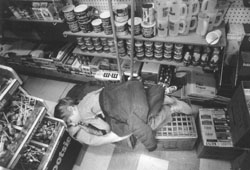 <a onClick="window.open('/olcweb/cgi/pluginpop.cgi?it=jpg::::/sites/dl/free/0073511935/234798/W14_1.jpg','popWin', 'width=NaN,height=NaN,resizable,scrollbars');" href="#"><img valign="absmiddle" height="16" width="16" border="0" src="/olcweb/styles/shared/linkicons/image.gif"> (19.0K)</a> <a onClick="window.open('/olcweb/cgi/pluginpop.cgi?it=jpg::::/sites/dl/free/0073511935/234798/W14_1.jpg','popWin', 'width=NaN,height=NaN,resizable,scrollbars');" href="#"><img valign="absmiddle" height="16" width="16" border="0" src="/olcweb/styles/shared/linkicons/image.gif"> (19.0K)</a>
Bob Thayer, The Journal-Bulletin
He shopped and he shopped, and then he dropped. | A study of grocery and supermarket shelves has shown that children's cereals, which contain about 45 percent sugar, are displayed at eye level to attract children whereas so-called adult cereals, which contain about 10 percent sugar, are placed higher.
The Center for Science in the Public Trust, lists percentages of sugar found in various cereals: | Cereal | Maker | % Sugar | | Ghostbusters | Ralston | 64 | | Apple Jacks | Kellogg | 49 | | Froot Loops | Kellogg | 45 | | Cap'n Crunch | Quaker | 42 | | Cocoa Pebbles | Post | 42 | | Trix | General Mills | 42 | | Corn Pops | Kellogg | 42 | | Cocoa Puffs | General Mills | 39 | | Lucky Charms | General Mills | 39 | | Frosted Flakes | Kellogg | 39 |
|
|

